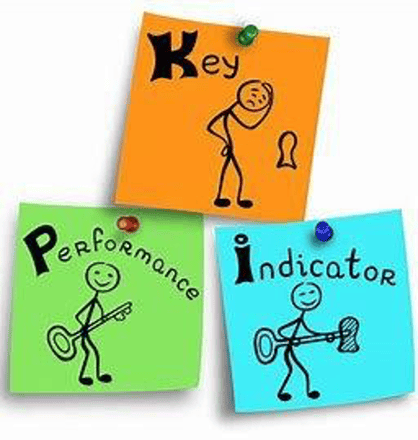If we were to suggest a game of Sales Strategy Meeting Bingo right now, we could almost bet our whole software performance management platform (but we won’t) on the question: “Could our sales KPIs be more effective?”, or “How can we build better sales KPIs”. And even, “Does anyone know what our sales KPIs are for this quarter?” If you’re still playing along at home, congratulations, you’ve just won yourself the right to read on and find out what are the most critical sales KPIs you should be implementing and why they matter.

If only sales KPIs were this simple
If you are intrigued by some of the other terms to be aware of in the sales world, check out this useful list.
And just before we begin, in case you are new to this and wondering what acronym world you’ve wandered into, a KPI, or Key Performance Indicator is by definition, a “measurable value that shows how effectively or successfully a business is meeting its objectives.”
It also cascades down to a team and individual level of performance monitoring, so getting the right KPI metrics established really matters.
1. Securing New Leads and Opportunities
The initial stage in any sales pipeline and what should mark the start of any negotiation is the uncharted territory of an area or district ripe with prospects. By setting clear sales KPIs, in terms of measures and targets against a territory or quota, you can clearly see if your team and the people within it are attaining it and whether it’s indeed realistic. By using and sharing the relevant areas of your sales performance management software, you’ll also be able to have a clear picture of how near sales executives are to reaching commission.
2. Prospects into Clients
It’s one thing building up a long lead list, but the true measure of sales KPIs is how many of these become bona fide customers? And aside from gaining a better understanding of the type of customer you’re acquiring, what makes this a valuable KPI is the insight gained into which of the sales team is making the conversions, who may be struggling, and which of these may be better as a warm-up act in the first stage? We’d advise that among the set criteria for this KPI you include contact methods (calls versus face-to-face meetings) and even training that’s been completed.
3. Location and Sales Volume
We like this sales KPI as it produces some of the most critical intelligence for your sales strategy. Whether you’re comparing two stalls of home-grown vegetables at two monthly farmers’ markets in two towns, or vast volumes of product across states, countries, or even continents, your transactions and location are the measures of business success or downturn. By comparing and analyzing sales metrics, you can see if failure to build a client list may also be down to quota management or a wrong decision on territory setting. And you can also use this insight to measure physical store sales against online purchases. The outcomes of this KPI should also be used when thinking about marketing and promotions, such as discounts, sales, or sample distribution.
4. Customer Relationship Management
Good customer relationship management (CRM) is no less important than the acquisition of new customers, and how you achieve this is a sales KPI that should always be in your top five. Ask yourself: How often do I follow up? Is there a way of capturing these interactions? Has the business got a full aftercare program established, and how simple is it for customers to reach out and speak to their contact? This is of course a two-way street, and how a relationship manager maintains and grows a customer relationship may not only be a business- or team-wide KPI but a measurable element of a robust Incentive Compensation Management (ICM) program. This metric should cover the regularity of contact, average call or meeting time, what repeat business means in terms of revenue per quarter or annum, and even client testimonials/satisfaction surveys.
5. Employee Happiness and Retention
Speaking of satisfaction, the welfare and happiness of those on the frontline are a sales KPI in their own hugely important right. While 2020 and the implications of the Covid-19 pandemic may have reduced the amount of people working in the field and increased the numbers working from home, the issue remains of how you keep a team motivated when they may not be operating under the same roof? When it comes to hitting all the sales KPIs, workplace culture must be embedded into any thinking or sales strategy. After all, a lack of human connection or understanding of objectives has the capacity to detrimentally affect some or all the other factors stated above.
If we’re to transform this wisdom into a living, breathing KPI, that would usually be in the form of an employee satisfaction survey. This becomes a powerful metric when staff completes this with a scale of numbers for each question or section, in addition to opinion. A business’ ability to positively respond to the findings rather than fudging the results builds not just a strong KPI but a loyal workforce that is more likely to stay and thrive.
So how are YOUR Sales KPIs?
This is by no means a definitive list – we haven’t even touched on deal size or net promoter scores – but it’s a solid base to build from: Know your business bandwidth, know your customer, know your employees, and you're well on the path to more effective sales KPIs that have purpose and meaning.
Discover how SPMs could help transform your own sales KPIs by visiting www.varicent.com or talking to your local Varicent representative today.



